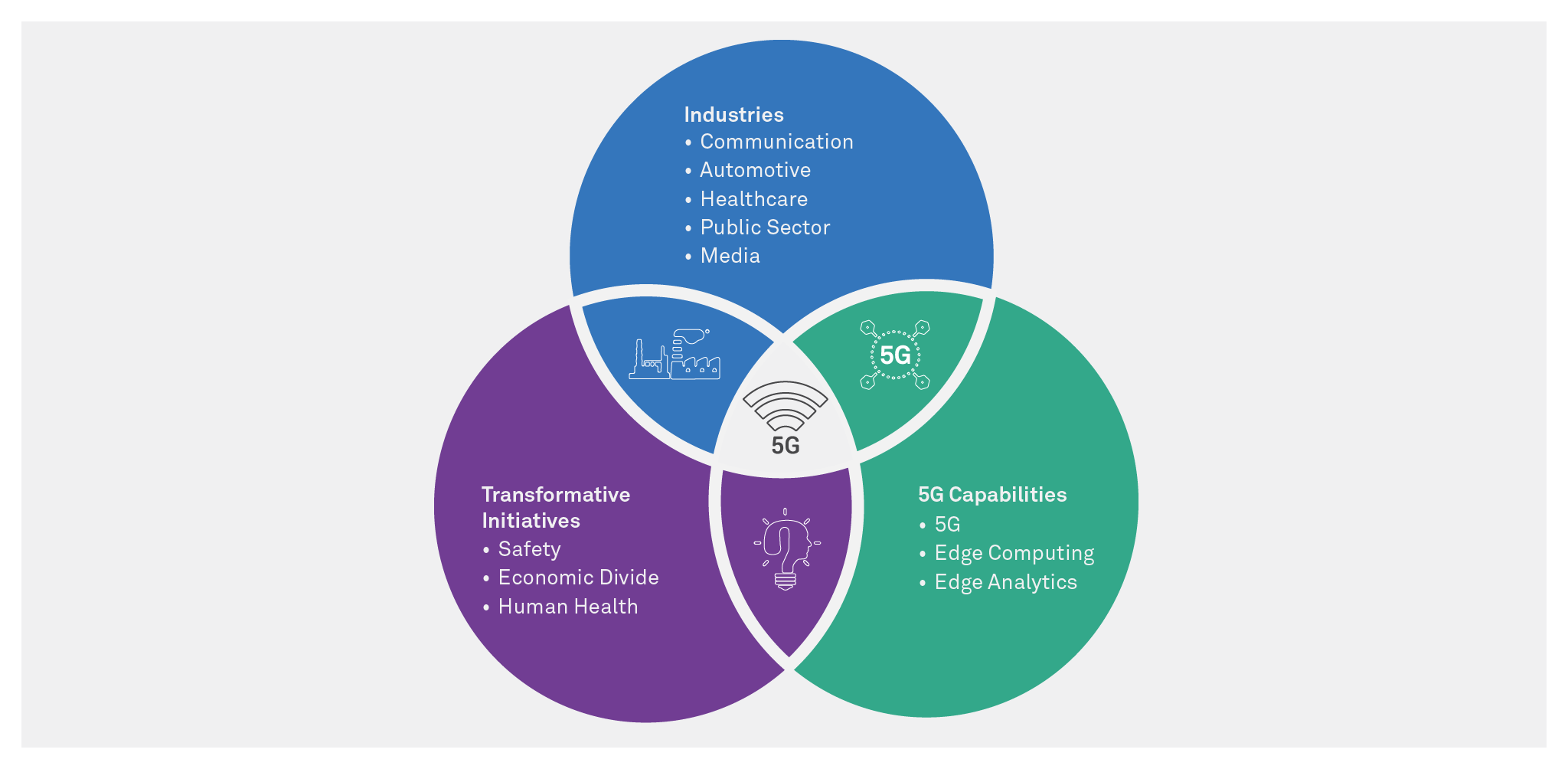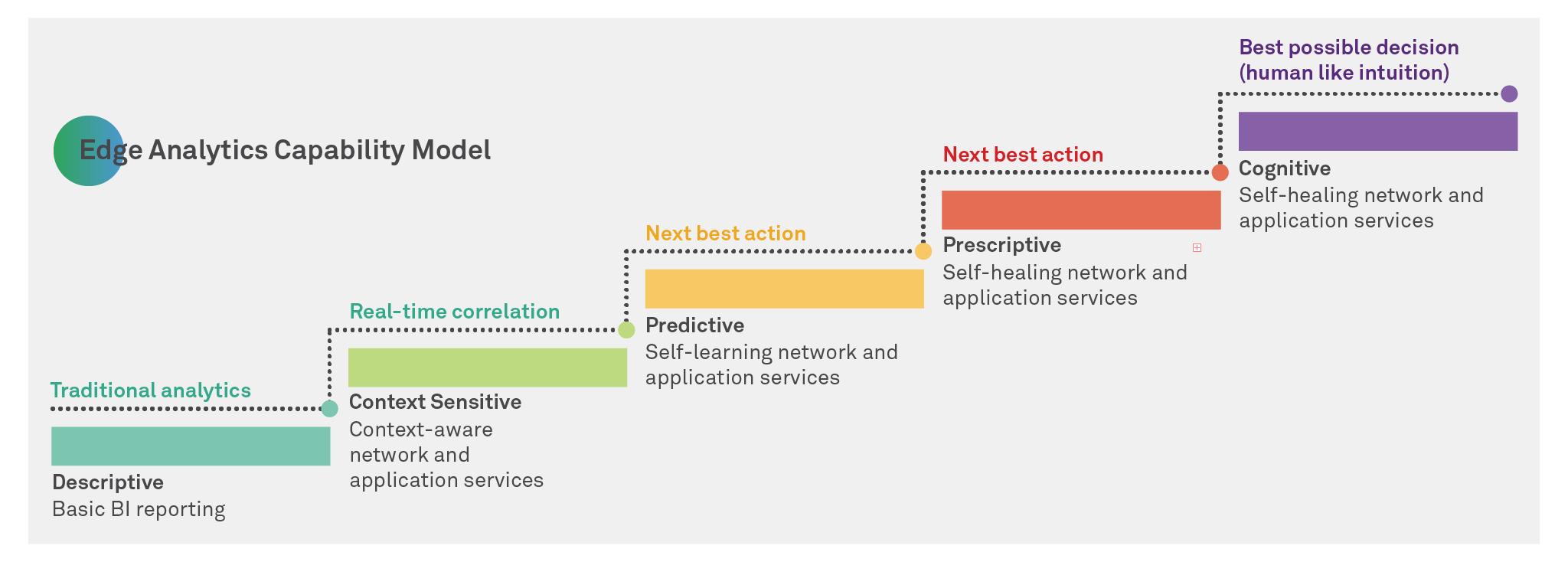Edge Analytics with 5G holds a transformative potential for humanity, impacting human health and safety and enabling smarter cities.
The transformative potential
The disruptive potential of 5G with Edge Computing (EC) and Edge Analytics (EA) may be more impactful than the Internet and Mobile combined (See Figure 1). The internet changed the way we discovered and utilized data, the mobile phone changed the way we interacted with each other and the data. 5G with EC and EA, will combine both of these changes and with an exponential speed and accuracy.

Figure 1: At the intersection of industries, transformative initiatives and 5G capabilities lies the true transformative potential of Edge Analytics
The race for smart cities is as much a business opportunity, as it is a humanity challenge. Technology has always shown most impact when addressing humanity challenges at scale.
With the advent of 5G+EC+EA, exponential benefits could be derived for smart cities across the globe, which could address not only the economic divide but also enable solutions dealing with safety (pedestrian and traffic), and human health (proactive and reactive services).
Tech foundation for transformation
5G edge analytics will drive revenue and lead to newer business models. 5G networks offer increased cell density, higher data speed and lower network latency.
In 5G, more processing is being pushed to the edge of the network, enabling the implementation of low latency applications. In addition, cell site densification provides increased network capacity, more data bandwidth and higher mobile data speeds to the consumers. This network densification will enable advanced analytics for real time decision-making.
The idea is to reduce performance bottlenecks on network bandwidth by storing and processing the data near the data-generating, end-user devices or the edge. This can enable innovative new applications and business models, uniquely powered by mobile edge computing. Gartner predicts that there will steady increase in the embedding of sensor, storage, compute and advanced AI capabilities in edge devices.
Edge Computing
Edge computing removes the dependency on a centralized data centre. Instead the applications, data, and services are decentralized and at the edge of a network. With edge computing, it is feasible to push flavours of AI and functions that formerly required big data centres into micro data centres (µDC) and AI processors closer to the user—at the originating device, at the enterprise or in an operator’s local access network.
Related read: Edge computing in a 5G network
Edge AI
Edge analytics and Edge AI adds analytics processing and AI to the edge. It utilizes the data on the edge including historic data for predictive scenarios and use cases and for optimizing end-services. Edge analytics application use-case spectrum is very broad including wearables, smart home, smart cities, autonomous cars and industry automation. The health industry stands to benefit greatly by using EA with wearables to monitor, identify issues and prescribe remedies affecting human health as early as possible.
Some unique application areas include:
Audio Analytics
Audio Event Detection: Detecting sounds such as that of a blast, a baby crying, or glass breaking will trigger an alert. Recognizing specific sounds from within overlapping sound sources is a critical ask that AI can fulfil.
Hands-free read and write facilities can be enabled by means of AI at the edge.
Inertial Sensor/Environmental Sensor Analytics
Inertial and environmental sensors in smartwatches and fitness bands with deep-learning-on-the-edge trigger faster response to local circumstances. Wearable devices collect data on human activity, location, pulse etc. and alert their wearers.
Video analytics
Video Analytics within automobiles help in detecting and alerting distracted and drowsy drivers through the eye position and the state of the eye.
Smart Cities
The advent of 5G means that cities will be able to use artificial intelligence to analyse the massive amounts of data being collected in a city; and then use that data for
• Utilities and Infrastructure
Edge analytics can enable a smart city municipality to better manage and conserve precious resources like energy, water and fresh air. Analytics on top of IoT sensors in water systems and waste management systems will enable better monitoring and management. Innovative electric grids will increase energy efficiency for businesses and consumers alike. Edge analytics will also help in the monitoring and controlling of building operations like HVAC, lighting, and security to enable best possible living environment to the building occupants.
• Economic Development and Civic Management
Traffic flow, parking space availability, utility usage and public streetlight management can be monitored by using IoT sensors on 5G network. Authorities can leverage edge analytics to find practical solutions to conserve energy, optimize water and power resources, and reduce environmental impact. Gradually, minimum traffic congestions and improved waste management will entice new residents and hence increase economic opportunities within the community.
• Public Safety and Crime Control
Edge analytics and Edge AI enable advanced and secure video, sensor and communication systems to proactively monitor public spaces and law & order. Using Edge AI, crimes or other disastrous events can be prevented or de-escalated before they jeopardize public safety. Sensors embedded in critical infrastructure such as bridges and power plants can monitor structural data to identify potential dangers, protecting citizens and the economic well-being of the city. Sensor-equipped drones can monitor vehicular traffic, crowds, construction sites and disaster areas to help monitor conditions continuously and support first responders. Overall, communities benefit from increased trust in law enforcement and disaster management.
• Intelligent Transport and Autonomous Intelligent Vehicles
Edge analytics will be the key enabler for the connected Autonomous Driving (AD) vehicles revolution using the Internet of Vehicles. Road vehicles will communicate with each other and with road infrastructures, improving overall road safety. It will also lead to reduced traffic congestions and enhanced driver comfort.
Edge computing based Vehicle-to-Cloud solutions enable edge cloud capabilities for different levels of autonomous driving through different services (e.g., high definition real-time maps, real-time traffic monitoring and alerts).
Distributed AI application in car will send video data over 5G radio to an edge computing site inside the Telco network. Video data will be processed in near real-time by Machine Learning algorithms at the edge cloud. Results of real-time image processing will be sent to the car, where comparison to local analysis will be done, leading to the final decision: i.e. instruction to the driver or the autonomous car.
Smart Healthcare
Healthcare is seeing a huge surge in the number of connected devices. EC and EA can reduce this burden to a great extent. A clinician’s mobile device can capture patient data into a connected analytics platform at the edge in real-time. Patients will no longer need to wait for analysed results, which would significantly reduce their number of visits.
The concept of the collaborative edge will be another enabler wherein geographically dispersed data is fused into a combined and edge device consumable view. For example, deep learning has recently gained relevance in ophthalmology due to its ability to detect clinically significant features for diagnosis and prognosis. This has resulted in various deep learning systems to be embedded within ophthalmic imaging devices, allowing automated image acquisition. The same can be performed at a smartphone-based device level, for instance by using a hi-resolution fundus imaging system attached to a smartphone.
Conclusion
The transformative potential of edge analytics will be realized. The speed of 5G networks coupled with the fact that local processing can be offloaded to the edge nodes/network makes the proposition of edge analytics very strong. Reduced latency, and connected, intelligent devices speaking to each other make for an invaluable leap from the current paradigm that requires sending large chunks of data back to the cloud for analytical processing and insights. Autonomous decision-making and cognitive intelligence at the devices or the edge network cut down both, processing and decision-making latency.
Edge analytics in 5G will not be restricted to traditional descriptive analytics and basic BI reports but will evolve to an extent that it will learn from the context, predict what will happen next, prescribe the next best action or decision, and learn from the past behavioural patterns for taking the most optimal decision. For fully autonomous applications, edge analytics will automate the next action in real-time. With the speed of 5G, more information will be collected and processed, and edge analytics generated insights will increasingly drive decision-making, leading to cognitive intelligence applications (See Figure 2).

Manish Sood
Consulting Partner, Analytics & AI Consulting, Wipro
Manish has more than 21 years of industry experience in Business Strategy, Business Consulting, Business Transformation and Digital Transformation. In the last decade, he has primarily consulted with clients on new digital payments product launches as well as digital transformation programs. Manish did his MBA in International Strategy and Brand Management from Goizueta Business School, Emory University, Atlanta and BE in Electronics & Telecommunication from University of Pune, India.
Shamit Bagchi
Data Scientist and AI Consultant, Analytics & AI Consulting, Wipro
Shamit works as a data scientist specializing in predictive and prescriptive analytics, machine/deep learning and AI consulting. He brings to the table both technical acumen and business consulting expertise based on over 15 years of experience in the Big Data and software industry, building value propositions for clients in Europe, US and India. He holds a Master of Science degree in Complex Adaptive Systems from Chalmers University, Sweden and an MBA in Marketing & Strategy from the Indian Institute of Management, Bangalore.